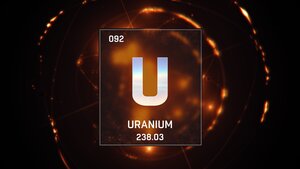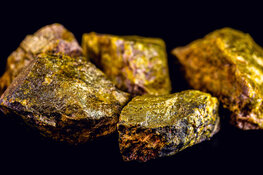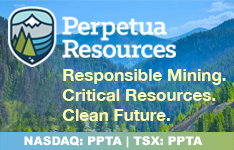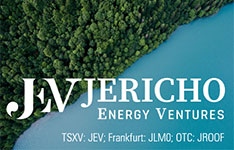Canada-based Skyharbour Resources Ltd. (SYH:TSX.V; SYHBF:OTCQX; SC1P:FSE) has built its core business model around mining uranium, an important strategic metal. The firm's primary focus is acquiring and exploring mineral property interests in the province of Saskatchewan.
Skyharbour Resources controls an expansive portfolio of exploration projects, including Moore Lake, Russell Lake, South Falcon Point, South Falcon East, Preston, East Preston, Hook Lake, Mann Lake, Yurchison, Riou River, Pluto Bay, Wallee, Usam Island, Foster River, and South Dufferin.
The projects are located across Saskatchewan, with Moore approximately 15 kilometers east of Denison's Wheeler River project and 39 km south of Cameco's McArthur River uranium mine.
The Catalyst: 8,000 Meters of New Drilling
Speaking with Proactive's Angela Harmantas at the PDAC conference, Coltura announced two of the company's proactive drill projects: 5000 meters of drilling at Russell Lake and 3000 meters at Moore Lake.
The 73,294-hectare Russell Lake Uranium property is situated in the central core of the eastern Athabasca Basin of northern Saskatchewan. Coltura, an Investor Relations Associate at Sentinel Market Services, represents Skyharbour and is quite excited about the new drill program.
"We believe there can be some high grades in between those holes, and we are very excited to do more systematic drilling," he explained in a recent phone call. "We are fine-tuning the targets."
Regarding the company's overarching goals, he explained that Skyharbour is "trying to be a one-stop show for uranium discovery, drilling, and exploration." He's particularly bullish about where the company's projects are located. He explained, "We are in the best place in the world to be developing uranium assets."
The Fraser Institute consistently ranks the Athabasca Basin as a top-5 mining district, and its location in Canada ensures more geopolitical stability than many uranium-bearing regions.
Why this Sector? The Fuel of the Future
Uranium is an essential form of nuclear fuel, but it's getting harder and harder for companies to access. Natural uranium found in the Earth's crust is a mixture of two isotopes, with Uranium-235, which is ideal for use in nuclear reactors, making up only about 0.7% of the total mineral weight.
Under certain conditions, Uranium-235 can readily be split, yielding a lot of energy. It is, therefore, said to be "fissile," from which we derive the term "nuclear fission."
According to a joint report by the Nuclear Energy Agency (NEA) and the International Atomic Energy Agency (IAEA), global uranium output in 2020 met nearly 90% of world reactor demand, dropping from 95% in 2017. Excess government and commercial inventories covered the remaining demand.
Existing world reactor requirements up to 2040 are projected to consume about 87% of the total 2019 identified resource base of 6,147,800 tonnes, creating ongoing tight market conditions.
The outlook around the nuclear and uranium mining industries has changed significantly over the past several years. It continues to improve thanks to three primary trends: decarbonization/clean energy, electrification, and energy security/independence.
Current global geopolitical unrest has only grown demand for uranium against the backdrop of a strained supply side further tightened by new financial entities sequestering material out of the market.
As the world transitions from carbon-intensive sources of electricity to carbon-free ones, many nations aim to be carbon-neutral by 2050. Countries are rethinking nuclear as the only viable energy source providing baseload, emissions-free, affordable, and scalable power.
The Washington Examiner reported on March 15 that U.S. "Lawmakers are upping calls to sanction uranium imports from Russia, hoping to see the U.S. nuclear fleet advance without relying on the Kremlin. But one major question looming over the effort is how supply would be maintained if such a ban were put in place."
"Several members of Congress have introduced legislation on the matter. Most recently, House Foreign Affairs subcommittee Chairman Tom Kean Jr. (R-NJ) said . . . that he's drafting a bill mandating the administration to decouple the United States and its allies from Rosatom, a Russian state-owned corporation that specializes in nuclear energy."
Many countries have moved to embrace nuclear as a reliable, carbon-free source of power that can help them meet their emissions reduction targets. Unfortunately, in the U.S., most of the uranium used in reactors is imported from foreign sources, with 48% from Russia and its allies, Kazakhstan and Uzbekistan.
Tightening supply means the U.S. is relying on Russia for nuclear fuel while also denouncing the country for its invasion of Ukraine.
Theresa Sabonis-Helf, a professor at Georgetown University, explained, "We are not yet in a position to meet all of our domestic nuclear fuel needs. We are definitely not in the position to extend nuclear energy supply security to our allies," during a hearing examining America's reliance on Russian sources of the spooky metal.
The U.S. Energy Information Administration reports domestic uranium supplies accounted for just 5% of reactor fuel used by U.S. nuclear power plants in 2022. The nuclear industry has been in a strange flux of psychologically driven downgrading since its initial boom during the 1950s. During that time, the U.S. quit several trade agreements with uranium-producing countries.
As Technical Analyst Clive Maund wrote on January 17, "Uranium prices look set to remain strong as it occupies the central position between the alternative means of energy generation and fossil fuel energy generation, which is being curtailed by New World Order zealots."
"Nuclear power generation is clean if you forget about the disposal of spent fuel rods or simply dump them in another country and if you are not stupid enough to site nuclear power stations on the coast in earthquake zones."
A recent report from David A. Talbot, Head of Equity Research Red Cloud Securities, says, "We view a positive short-and-long-term outlook for nuclear power and SMRs given proactive government policies, public acceptance, better economics, climate change impacts, and security of supply. This positive outlook resulted in additional uranium demand and higher prices."
"We saw an evolution of uranium price appreciation drivers during 2023, with consistent price gains at first, gaining more speed by Sep-23 through Q4/23, with ongoing price spikes continuing into 2024."
"Fortunately, we are starting to see the much-needed uranium price incentive, leading to exploration and mining projects being taken off the shelf, new exploration companies are emerging, and equity investment into uranium stocks continues at a torrid pace."
Why This Company?
Skyharbour Resources, located in a favorable friend-shore jurisdiction, is well-positioned to capitalize on the nuclear market's upswing.
The US federal government has dedicated billions in funds to the production of both high-assay, low-enriched uranium (HALEU) and low-enriched uranium (LEU), which are used for nuclear reactor fuel and medical isotope production. HALEU is needed to power modular reactors that are smaller and safer than traditional nuclear sources.
According to the World Nuclear Association, Russia and China are the only countries that produce HALEU on a large scale. The US will not soon develop HALEU production at a commercial scale sufficient to meet current demand. According to Adam Stein, the head of the Nuclear Energy Innovation program at Breakthrough, this sluggishness is due primarily to the lack of a "clear demand signal from the market."
"We need the fuel to be on its way to being available so that utilities will have the confidence to buy the reactors and [confidence] that they will be able to fuel them," Stein told the Washington Examiner.
Centrus Energy, a nuclear fuel supplier, produced the U.S.'s first demonstration-scale HALEU at its Ohio facility. Unfortunately, It's only expected to produce roughly one metric ton of HALEU per year, far below the country's estimated need of 40 metric tons by the decade's end. The facility is the only federally-licensed HALEU plant in the country. The White House recently signed an appropriations bill that provided $2.7 billion to support the production of HALEU.
"We need a coordinated strategy, an effort to reinforce that Washington and our allies won't return to business as usual with Russia when the war in Ukraine ends," Anthony Ruggiero, a senior fellow at the Foundation for Defense of Democracies, told the House Foreign Affairs Subcommittee on Europe. He recommended that Congress mandate the move through legislation if the White House fails to act.
Subcommittee Chair Kean said his legislation would address nuclear dependencies relating to medical and industrial isotopes, which he said would take longer to unwind from. He explained that the bill's authority is narrow and would instead complement legislation introduced by House Energy and Commerce Committee Chairwoman Cathy McMorris Rodgers (R-WA).
That bill passed the House unanimously last December and bans imports of unirradiated, low-enriched uranium produced by Russia or a Russian entity.
"These two bills together would send a much-needed market signal to the civil nuclear industry," Kean said. "The result will be a safer supply of nuclear fuel for the U.S. and its allies."
Professor Sabonis-Helf warned in her testimony that sanctions against Rosatom could threaten the security of nuclear power plants in Europe.
"Most sanctions against Rosatom, however intuitively appealing, will neither constrain Russia significantly nor will they address the current nuclear fuel imbalance that the world faces," she concluded. "Sanctions could disrupt markets in ways that could boost Rosatom's revenue while disadvantaging ourselves and our allies."
According to a February 7 report by Clive Maund, "Skyharbour has a lot of uranium exploration projects in [the friendly and US-adjacent jurisdiction of] Canada, many of which are drill ready."
"With commodities generally and uranium in particular expected to continue in an accelerating bull market against the background of increasing inflation, Skyharbour stock looks set to do well," he explained.
"On the 2-year log chart, we can see the fine uptrend that started from the March 2020 general panic lows and which remains in force, with the reaction back across the channel from the peak last September to contact the lower rail of the channel, setting it up for the next major up-leg."
Why Now? Well Positioned To Profit
The Red Cloud Securities report states, "Uranium prices rose 110% to US$101/lb U3O8 since the start of 2023. Supply/demand early in 2023 was partially driven by physical uranium purchases. By Q3/23, uranium prices were driven largely by utility and later financial entity demand, while Q4/23 uranium price spikes were due to speculation surrounding positive US Government funding and policies, with added speculation surrounding a potential Russian uranium import ban."
"Q1/24 uranium price fluctuations appear somewhat more volatile in both directions but are biased to the upside on supply-side disruptions. Our top uranium picks include . . . Skyharbour Resources."
Skyharbour Resources also announced on February 28 that it had added 64,267 hectares to its Athabasca Basin holdings through low-cost staking. The company now has an interest in 587,364 hectares (over 1.45 million acres) across 29 projects in and around the Basin.
The new 100%-owned claims are located in Wollaston Domain, just outside the Athabasca sandstone; they are underlain by prospective Wollaston Supergroup metasedimentary gneisses, including lower Wollaston pelitic gneisses.
The new properties include:
- Bend Project: Two mineral claims covering 9,114 hectares.
- Compulsion Project: Two mineral claims covering 10,451 hectares.
- Genie Project: Five mineral claims covering 16,930 hectares.
- Hartle Project: Ten mineral claims covering 52,518 hectares.
- Regambal Project: Five mineral claims covering 24,208 hectares.
Several other claims were re-staked during competitive staking rushes in the Usam and Riou River areas. The newly re-staked Usam project consists of 40,041 hectares over 12 claims, covering a large portion of prospective Wollaston Supergroup metasedimentary gneisses northeast of Cameco Corp.'s Rabbit Lake Operation.
Riou River now consists of 8,620 hectares over six claims in the north-central portion of the Athabasca Basin and is underlain by Athabasca Supergroup sandstone and conglomerate.
Three new claims non-contiguous with the original claim were added to the company's Highway project, adding 8,155 hectares to the project and increasing its size to 9,339 hectares. These new claims are also located close to Highway 905.
On January 7, analyst Maund wrote, "We had a sizeable profit in uranium stock Skyharbour Resources Ltd., which we bought at a very good entry point early in August, but missed opportunities to take these profits late in September and again in mid-November ahead of a significant but normal correction."
"We can see all this on its latest 6-month chart below, and the reason for bringing it to your attention now is that it is believed to be at a very good ‘buy spot' here ahead of renewed advance rather like Snowline Gold Corp. that we picked up at a similar low in mid-November before it took off higher again."
"The reasons that the corrective downtrend from mid-November is believed to be normal is that it has brought the price back to a point above its still rising 200-day moving average, where it appears to be stabilizing, and in addition, the Accumulation line has held up very well on the correction, almost flatlining, which is bullish."
"With Skyharbor now deeply oversold and at a support level, this looks like an excellent point to buy or add to positions ahead of renewed advance."
Skyharbour Resources is well-positioned to benefit from improving uranium fundamentals as the market bifurcates. With a total portfolio of 15 projects covering over 1.1 million acres, the firm is actively advancing its core assets, including Moore and Russell Lake, while using a prospect generator model to option out secondary properties to partner companies who fund the exploration and pay Skyharbour cash and shares to earn in.
According to firm management, "The last 12 months have been significant for Skyharbour, and we believe that the next 12 to 18 months will continue to be transformational for us and our shareholders."
"We've recently optioned the Russell Lake Uranium Project from Rio Tinto, bringing them on to be a strategic shareholder of the Company. The large, 73,000-hectare property hosts numerous high-grade uranium in historical drill holes and holds several high-priority targets with the potential to generate new discoveries."
"After extensive data compilation, interpretation, and new geological modeling, our geological team has refined and selected the highest-priority drill targets. We have plans to rapidly advance the project through multiple phases of drilling over the next 12 months, utilizing existing roads and infrastructure in the area."
In conjunction with the Russell Lake Project, Skyharbour plans to advance its 100% owned flagship Moore Project, an advanced-stage uranium exploration property with high-grade uranium mineralization.
"We have plans to continue drilling the project as large portions of the high-grade Maverick corridor have yet to be systematically tested, leaving robust discovery potential along strike as well as at depth in the basement rocks," the ownership team explained. "There are several high-priority regional targets at the project that display strong discovery potential as well."
According to a report from Peter Epstein at Epstein Research, "Management is focusing the majority of its largest-ever drill program at Russell. If meaningful discoveries are made at Russell or ML, that would draw a lot of attention to the story. Either as satellite deposits for a nearby mill or a standalone mine — sizable high-grade endowments would be mined."
Ownership and Share Structure
The company has a market cap of CA$56.5 million, with 144.9 million shares, 29.8 million warrants, and 7.3 million options outstanding for a fully diluted base of 182 million. Some warrants priced at 22 cents expire at the end of November, but most have been exercised over the last several months, with only a small number left. Company insiders and some close business associates own them.
Skyharbour Resources has some CA$7 million in the bank, with another CA$3 million in option partner payments expected over the next 12 months. Its monthly burn rate is CA$125,000.
The company said management and insiders own approximately 2.5% of the company. According to Reuters, President and CEO Jordan P. Trimble owns 1.54% of the company with 2.79 million shares, Director David Daniel Cates owns 0.70% of the company with 1.27 million shares, and Chairman of the Board James Gaydon Pettit owns 0.23% of the company with 0.42 million shares.
Skyharbour said institutional, corporate, and strategic investors own approximately 55% of the company, as Alps Advisors, Inc., owns 8.28% of the company with 14.99 million shares, Mirae Asset Global Investments (U.S.A) L.L.C. owns 4.83% of the company with 8.76 million shares, Sprott Asset Management L.P. owns 2.74% of the company with 4.96 million shares, M.M.C.A.P. Asset Management owns 2.02% of the company with 3.66 million shares, Incrementum AG owns 1.30% of the company with 2.36 million shares, Vident Investment Advisory, L.L.C. owns 0.34% of the company with 0.61 million shares, and DWS Investment GmbH owns 0.33% of the company with 0.60 million shares.
According to Reuters, there are 181.16 million shares outstanding with 176.36 million free float traded shares, while the company has a market cap of CA$83.3 million and trades in the 52-week period between CA$0.32 and CA$0.64.
| Want to be the first to know about interesting Uranium investment ideas? Sign up to receive the FREE Streetwise Reports' newsletter. | Subscribe |


